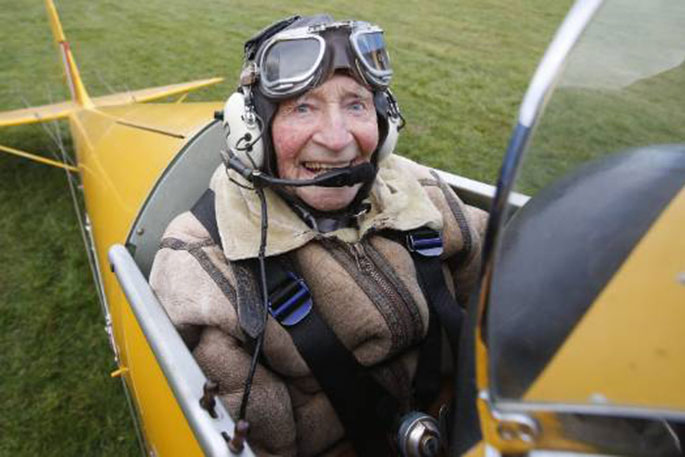Memories came flying back for World War II fighter pilot Bryan Cox when he took to the skies above South Canterbury in the same Tiger Moth plane he last flew 75 years ago.
The 93-year-old Tauranga man performed the flight at the Rangitata Island Aerodrome on Sunday in front of a sizeable crowd.
"It was quite the nostalgic experience."
Bryan flew the Tiger Moth during his elementary flying training at RNZAF Station Harewood (now Christchurch International Airport).
He flew Kittyhawks and Corsairs during the WWII, embarking on combat operations against the Japanese at just 19 years old.
He served three tours in the South Pacific, and spent a year in Hiroshima after WWII.
During WWII, there were more than 13,000 trained RNZAF crew. There were more than 4000 casualties.
On Bryan's 20th birthday, he witnessed several of his fellow fighter pilots perish in a dogfight.
"There were 15 of us, only eight of us which landed. I am a bit lucky. I was about to bail out in darkness, but in a flash of lightning I saw the trees under me. The flash saved my life.
"Survival was the main aim. If we crashed or were shot down we probably wouldn't survive from the treatments that were available at the time. We had to keep that in mind."
Bryan says he thought most of his fellow pilots were conscious of the effect on their parents if we got killed.
"We endeavoured as much as possible for that not to happen. But by the same token, it all went out the window when you were engaged in combat."
The RNZAF had more than 420 Corsairs in operation during WWII, Cox estimates he flew more than 113 of them.
"They were all identical, it didn't make any difference which one we flew."
During Sunday's flight, Bryan performed an array of aerobatics in the Tiger Moth, taking over the controls from Andrew Love who undertook the takeoff.
"It took more stick forces that I've done in other aeroplanes. It seemed to be trickier flying the Tiger than flying a modern day plane, which these days operate more like driving a car.
"It's 75 years since I flew a Tiger Moth, I thought it was heavier on the controls than I expected.
"Aerobatics is something I have done all my career. It's the freedom and ability to manoeuvre an aircraft in every circumstance. A bomber pilot was a sitting target, but a fighter pilot is completely dependent on their own skills to survive."
After the war, Bryan went on to have a long and distinguished career in aviation mainly as a flight instructor, amassing 21,000 hours in the air, and writing several books on his experiences.
"It's changed a lot, being a flight instructor. When I started about 90 per cent of trainee pilots were recreational and 10 per cent were commercial, now it's the other way around."
Earlier this year, he became one of New Zealand's oldest pilots when he received his recreational pilot licence at age 93.
"I think the instructor was more surprised that I was."
The Tiger Moth biplane is now owned by Russell Brodie of Rangitata Island Aerodrome.
Sunday's flight was set up when Russell enlisted the help of air force historian and founder of the Wings Over New Zealand Show, Dave Homewood, to identify any surviving veterans who had flown his Tiger Moth during World War II.
Dave discovered an entry in his log book confirming that Cox had flown the aircraft during his training.
Asked whether he would fly a Tiger Moth biplane again, Bryan says it's unlikely.
"I've sort of accepted it was going to be my last flight in one of these, but I'm pleased to have done it.
"I'll be 94 next birthday, but I doubt I'll outlive this aircraft."



0 comments
Leave a Comment
You must be logged in to make a comment.